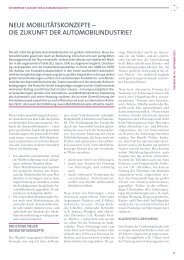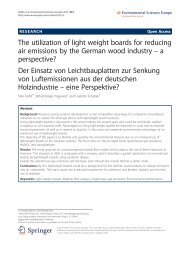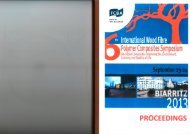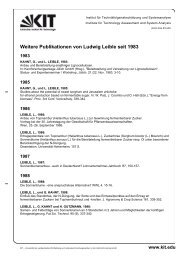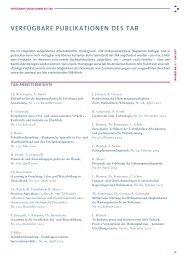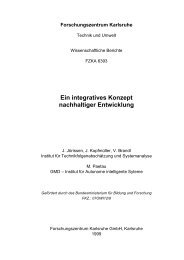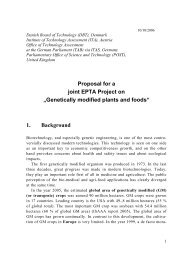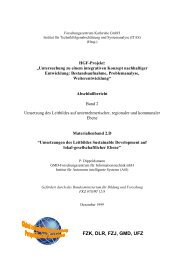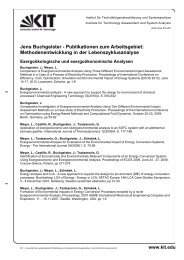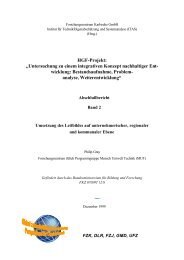Results: RFID and Identity Management in everyday life - ITAS
Results: RFID and Identity Management in everyday life - ITAS
Results: RFID and Identity Management in everyday life - ITAS
You also want an ePaper? Increase the reach of your titles
YUMPU automatically turns print PDFs into web optimized ePapers that Google loves.
than just border control. Although this is ma<strong>in</strong>ly triggered by the biometric database <strong>and</strong> not by <strong>RFID</strong>,<br />
contactless communication facilitates the exchange of biometric <strong>in</strong>formation <strong>and</strong> is therefore also seen<br />
as responsible. One such function added to border control is that the biometric database will itself be<br />
an analyses tool. For example: search<strong>in</strong>g for potentially hazardous people on the basis of their<br />
appearance. A picture can for example tell much about someone’s religion or race. Another function<br />
creep <strong>in</strong>volves connect<strong>in</strong>g the central database to other databases, gett<strong>in</strong>g a full picture of a person<br />
whereabouts <strong>and</strong> be<strong>in</strong>g sure the person actually is who they appear to be. It’s for this reason<br />
organisations such as the Dutch Data Protection Authority are opposed to a central database for the<br />
biometric passport. Also, many reactions <strong>in</strong> newspaper claim the biometric passport is just another<br />
step towards a Big Brother regime. Put more subtle, the Radboud researcher’s state:<br />
“The possibility of biometric identification of the entire (passport-hold<strong>in</strong>g)<br />
population <strong>in</strong>volves a change of power balance between states <strong>and</strong> their<br />
citizens. Consent or cooperation is then no longer needed for identification.<br />
Trac<strong>in</strong>g <strong>and</strong> track<strong>in</strong>g of <strong>in</strong>dividuals becomes possible on a scale that we have<br />
not seen before.” [Hoepman et al 2006: 11]<br />
They expect some political groups will be likely to combat the <strong>RFID</strong> passport. These groups could for<br />
example persuade people to put their passport <strong>in</strong> the microwave, destroy<strong>in</strong>g the chip while sav<strong>in</strong>g its<br />
physical appearance. Even stronger, such a political action group could build disruptive equipment to<br />
destroy the <strong>RFID</strong>-chips from a distance without the holder notic<strong>in</strong>g. Yet, as for now, citizens are<br />
comply<strong>in</strong>g with the new passport. <strong>Identity</strong> <strong>Management</strong> issues from the side of users are currently<br />
ma<strong>in</strong>ly on practical problems with biometrics, as it took many people much effort to get their picture<br />
right. They had to look straight <strong>in</strong>to the camera <strong>and</strong> were not allowed to smile, which gave them a<br />
feel<strong>in</strong>g of be<strong>in</strong>g squeezed <strong>in</strong>to a uniform format. Also, early tests show facial recognition does not<br />
always work well, especially with children <strong>and</strong> elderly.<br />
Once the majority of the European population has an <strong>RFID</strong> passport, new, perhaps unanticipated<br />
applications may be suggested. Be<strong>in</strong>g the ultimate <strong>Identity</strong> <strong>Management</strong> application, banks, <strong>in</strong>surers<br />
<strong>and</strong> other organisations would want to use it too to manage the identity of their customers. How<br />
Europeans then try to take <strong>Identity</strong> <strong>Management</strong> back <strong>in</strong>to their own h<strong>and</strong>s rema<strong>in</strong>s to be seen.<br />
Tak<strong>in</strong>g care: <strong>in</strong>formed medics, secur<strong>in</strong>g patients<br />
F<strong>in</strong>ally, one sett<strong>in</strong>g which could be part of <strong>everyday</strong> <strong>life</strong> is be<strong>in</strong>g taken care of by medical specialists,<br />
both <strong>in</strong> the hospital environment as <strong>in</strong> homecare. When it comes to <strong>RFID</strong> <strong>in</strong> a healthcare sett<strong>in</strong>g,<br />
almost everyth<strong>in</strong>g can be tagged for some purpose: assets, patients, pharmaceuticals, blood bags,<br />
laboratory samples <strong>and</strong> staff. With item-level tagg<strong>in</strong>g Real Time Locat<strong>in</strong>g Systems can be used. In the<br />
case of assets <strong>and</strong> staff for <strong>in</strong>stance, this is done for theft prevention <strong>and</strong> rapid location. The tags can<br />
also serve as an ‘electronic h<strong>and</strong>shake’, mak<strong>in</strong>g sure the right procedure is followed. Patients,<br />
pharmaceuticals, blood bags <strong>and</strong> laboratory samples are tagged for this purpose of error prevention.<br />
Furthermore, tags on pharmaceuticals function <strong>in</strong> anti-counterfeit<strong>in</strong>g. In addition a newborn <strong>and</strong> his or<br />
her mother can be tagged for mother-baby match<strong>in</strong>g. F<strong>in</strong>ally, patients could tagged for drug<br />
compliance <strong>and</strong> supervision of the cognitive impaired. [Harrop, P. & Das, R., 2006; Garf<strong>in</strong>kel, S. &<br />
Rosenberg, B. 2006] Nevertheless, although many possible uses are be<strong>in</strong>g developed <strong>and</strong> <strong>in</strong> some<br />
cases tested, we found very few actual accounts of <strong>RFID</strong> <strong>and</strong> <strong>Identity</strong> <strong>Management</strong> <strong>in</strong> healthcare<br />
sett<strong>in</strong>gs. Tagg<strong>in</strong>g items has become quite common, ma<strong>in</strong>ly for logistic purposes, but for some reason<br />
or another, identify<strong>in</strong>g patients with <strong>RFID</strong> is not (yet) common practice.<br />
One case we encountered <strong>in</strong> Imatra, F<strong>in</strong>l<strong>and</strong>. Here medication compliance is controlled by the<br />
Medix<strong>in</strong>e <strong>RFID</strong> Communication Board [case #133]. People suffer<strong>in</strong>g from Alzheimer’s disease are<br />
enrolled <strong>in</strong> the trial. Accord<strong>in</strong>g to Medix<strong>in</strong>e they are suitable for this application, because they have no<br />
problems <strong>in</strong> adm<strong>in</strong>ister<strong>in</strong>g the medication, but they need a rem<strong>in</strong>der to do so sometimes. The <strong>RFID</strong><br />
27



